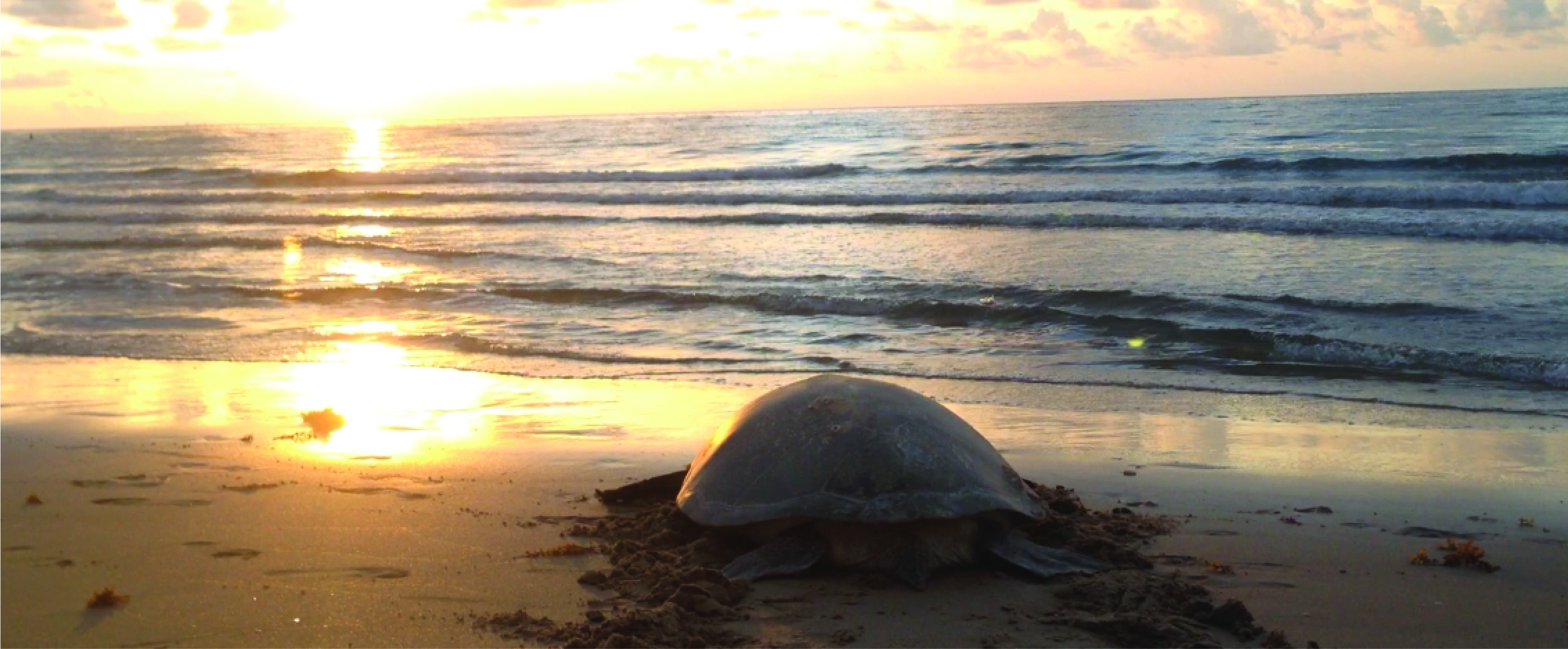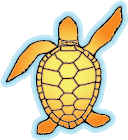About Sea Turtles
Sea turtles are large, air breathing, ectothermic reptiles that have adapted for life in the sea. They have paddle-shaped flippers instead of feet, streamlined bodies, salt glands, and cannot retract into their shell like a land turtle can. Sea turtles have ancestors pre-dating the dinosaurs 245 million years ago. The difference between them and their ancestors is size, they are a lot smaller today. Archelon, the largest sea turtle known, swam the waters 70 million years ago, was 16 feet from flipper to flipper and weighed over 5,000 pounds. The leatherback, the largest living sea turtle, is 7 feet from flipper to flipper and can weigh up to 2,000 pounds.
Seven species of sea turtles have managed to survive to modern times. All are considered threatened or endangered. Three of these species; the loggerhead (Caretta caretta), green (Chelonia mydas), and leatherback (Dermochelys coriacea) sea turtles nest on Broward County’s beaches, and two of these species; the hawksbill (Eretmochelys imbricate) and Kemp’s ridley (Lepidochlys kempi) are seen offshore.
Mainly overharvesting of sea turtles for meat, eggs, leather, and tortoise shells up until the 1970s caused turtle populations to crash. All species of sea turtles are threatened or endangered and protected through Florida Statues, Chapter 370, and by the United States Endangered Species Act of 1973. Briefly, these laws state that: "No person may take, harass, harm, pursue, shoot, wound, kill, trap, capture or attempts to engage in any such conduct to marine turtles, turtle nests, and/or turtle eggs." Any person who knowingly violates any provision of the act may be assessed civil penalties up to $25,000 or criminal penalty up to $100,000 and up to one year imprisonment.
Sea turtle populations have been seriously reduced worldwide through a number of human influences. Pollution of the waters via trash, chemicals, and discarded fishing nets, lines, and hooks are frequently ingested by sea turtles causing internal health issues. Incidental capture of sea turtles in fishing nets and shrimp trawls, can prevent sea turtles from reaching the surface to breathe. Overdeveloped coastal areas have reduced natural nesting habitats and caused increased lighting which disorients hatchlings and nesting mothers. Boaters need to use caution as sea turtles can be primarily found at or just below the surface in coastal and inland waters especially during mating, nesting, and hatching season. Only 1 in 1,000 hatchlings that make it to the ocean will survive to adulthood, this is due to all the natural and anthropogenic obstacles they face. For these reasons all sea turtle species are protected.
In the Atlantic, the loggerhead sea turtle and green sea turtle are listed as threatened. The leatherback, hawksbill, and Kemp’s Ridley sea turtle species are listed as endangered everywhere.
The extent of the development on the beaches of Broward County and associated bright lights from condos, streets, and highway traffic have caused many problems for sea turtles, and hatchlings in particular. Most of the nests in Broward County were relocated by permitted personnel to a safer beach area or hatchery where hatchlings could exit the nest and transverse the beach to the water on their own. Nests that were not moved were those that are already on safe beaches, although those were few and far between. As of 2006, this management strategy was largely removed from the Broward County program. With the active enforcement of local lighting ordinances now being aggressively pursued, safer beach areas were created and have eliminated the relocation of most nests.
Today, there is a hands off approach, leaving as many nests in situ (natural position) as possible. Relocation of eggs only occurs when the eggs are deposited in an area that compromises the success of egg development (below the high tide line, where the nest will be washed away, etc).
Incubation of Loggerhead and Green nests take about 45-55 days. Leatherback eggs take a bit longer, reaching upwards of 70-80 days. . After this period, the hatchlings emerge from the nest en masse and, using various environmental and instinctual cues, quickly migrate to the water's edge. If artificial lights are lighting the beach the hatchlings can disorient, crawl the wrong direction, and possibly never make it to the water.
In areas with coastal lighting and high disorientation rates we now place restraining cages over the egg chamber of nests. The black mesh restraining cage is installed close to hatching range. It is monitored every day where the seaward door is opened at dawn and closed at dusk while checking for hatchlings throughout the night. This cage collects the hatchlings so they do not disorient towards the artificial lights into streets, storms drains, and other dangerous areas. During the checks if our authorized personnel come across hatchlings inside the cage piled on the west side of the cage they will remove the hatchlings and conduct a controlled release.
Once in the water, the hatchlings swim directly out to sea facing a perilous struggle to survive to adulthood. The best scientific estimates available indicate that only one in 1,000 to 10,000 hatchlings will survive (anywhere from 20-50 years) to become an adult sea turtle.
Please call the Sea Turtle Emergency line (954-328-0580) if you find hatchlings in Broward County headed away from the sea, on the road, or in a restraining cage.
Our program, in conjunction with Anne Kolb Nature Center at West Lake Park in Hollywood, conducts public hatchling releases from July through August ever Wednesday and Friday as part of the Sea Turtles and Their Babies Program. Please contact them directly for reservations (954-357-5161 ext 0), which are required.
Sea turtles demonstrate nocturnal behavior by mostly nesting and hatching at night. Leatherbacks typically nest from early March through mid-June. This species accounts for less than 1% of the nests in Broward County. Loggerheads are the County's most common nester, accounting for 90-95% of all nests. This species tends to nest from April through early September with peak nesting in June and July. Green turtles nest from late May through early September, tending to have alternating extreme high and low nesting seasons.
If undisturbed, the female leaves the water and crawls up the beach to a point well above the high tide line. She uses her front flippers to create a primary body pit where she gets herself level with the surrounding sand. Then, using her rear flippers, she digs an egg chamber 2-5 feet deep that looks like an upside down light bulb. After resting briefly, she then fills the hole with about 80-120 ping-pong ball sized eggs, gently covers the eggs with sand, and then spreads sand over a wide area with her front flippers to camouflage the location of the chamber. She then leaves the nest site and reenters the water.
An individual loggerhead will nest 2-3 times per season, green female sea turtles will nest 3-4 times per season, both typically at 2-3 week intervals. Leatherbacks will nest 5-7 times per season at 10-day intervals (approximately). She will not nest every year but rather every other year or third year. This will depend on a number of factors including environment, food availability, genes, and parasites, and other variables. Adult sea turtles do not nurture their hatchlings, so the female never visits the nest site again.
An individual turtle will nest within 5 miles to 35 miles of the region, on average, of where they hatched and/or nested in the past, based on tagging studies. There is also evidence that the hatchlings can detect variations in the earth's magnetic field and that may be one way they navigate back.
Approximately 50% of the time, the female exits the water without digging a nest. These are called false crawls and usually occur because the turtle was disturbed or it could not find a suitable nest site. In Florida, the crawl tracks left on the beach are always made by female sea turtles and they resemble marks left by a tractor tire.
Mainly at night. Leatherbacks nest from early March through mid-June typically, but this species accounts for less than 1% of the nests we get in Broward County. Loggerheads are our biggest nester and tend to nest from April through early September, with peak months being June and July. Greens nest from late May through early September, with alternating extreme high and low nesting seasons.
Depends on the species. Average for loggerheads and greens are about 100-110 ping-pong ball sized eggs. Leatherbacks lay about 90 tennis ball sized eggs. All sea turtle eggs are leathery and somewhat soft so they dent instead of breaking.
Adult loggerheads average 300-350 lbs. Greens can way up to 500 lbs. Leatherbacks can get up to 1500 lbs (the biggest being recorded at 2000 lbs).
There has not been a turtle followed from emergence to natural death. Onset of sexual maturity is also species dependent, but is typically around 20-25 years.
Loggerheads and green eggs hatch in about 45-55 days. Leatherback eggs take a bit longer, reaching upwards of 70-80 days, sometimes longer.
A natural or in situ nest will have a hatching success rate of 80-100%, while a relocated nest will have a hatching success rate of 60-70%. Overall, only one in 1,000 to 10,000 sea turtles will live to maturity. Major predators after nest emergence include birds, fish, crabs, and foxes.
As hatchlings, you can't tell by looking. As adults, males have a much longer tail than females. Sand temperature affects gender: 29.6 degrees Celsius during the middle third of incubation will produce a 50:50 gender ratio. A couple of degrees higher will produce all females and a couple of degrees cooler will produce all males.
Yes, that seems to be the case. An individual turtle will nest within 5 miles to 35 miles, on average, of where they hatched from and/or nested in the past, based on tagging studies. There's also evidence that the hatchlings can detect variations in the earth's magnetic field and that's how they navigate back.
Yes, an individual loggerhead or green female will nest 2-5 times per year, typically at 2-3 week intervals. Leatherbacks will nest 7-10 times per year at 10 day intervals (approximately). She will not nest every year however, but rather every other year or third year. This will depend on how well they eat during the year/non-nesting season.


